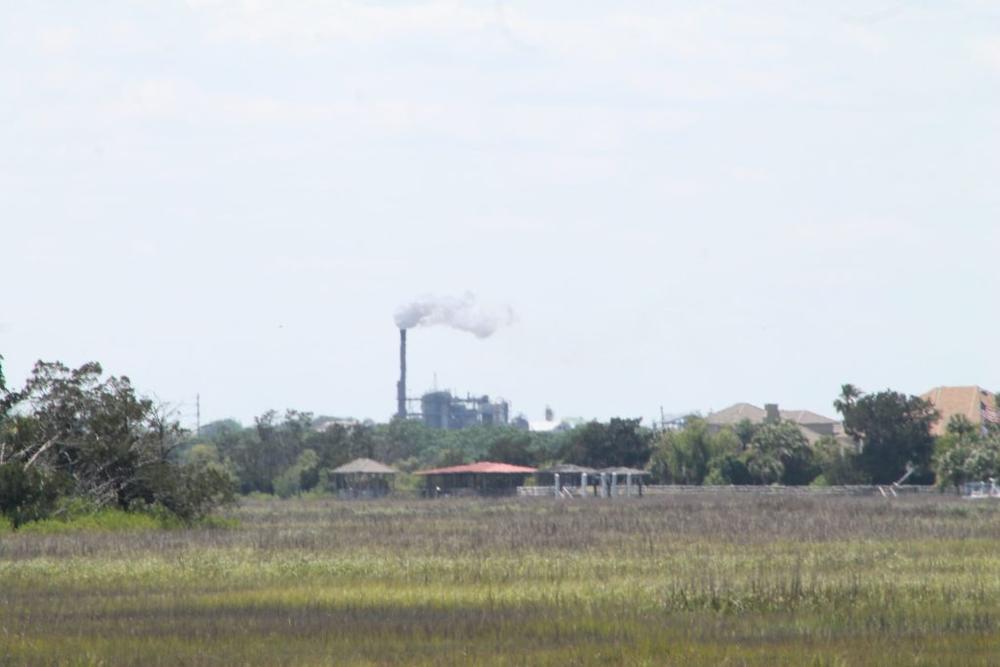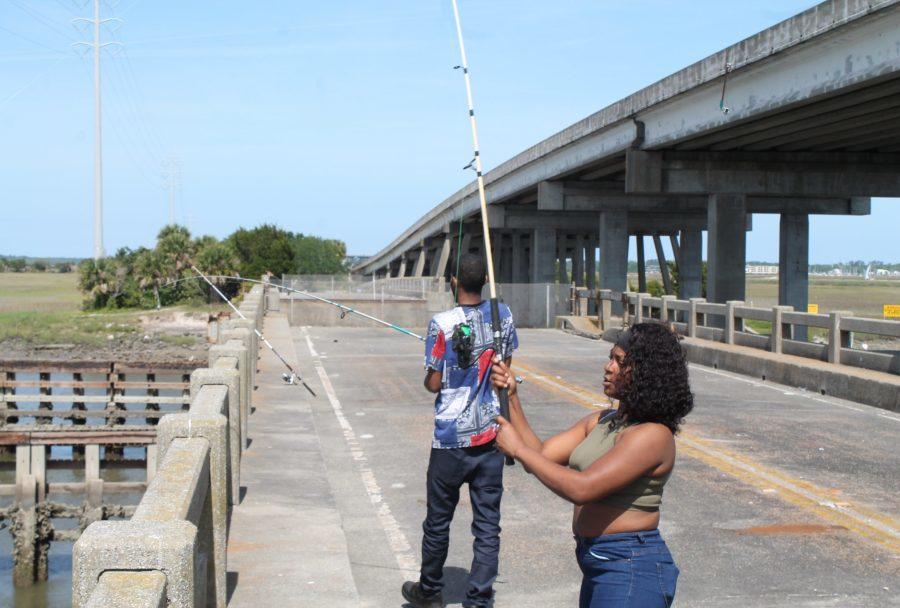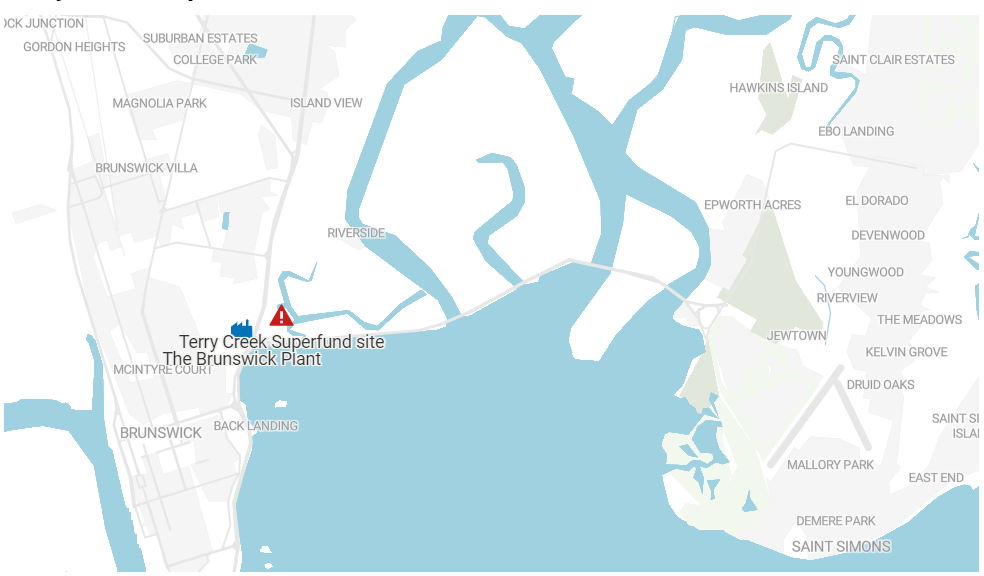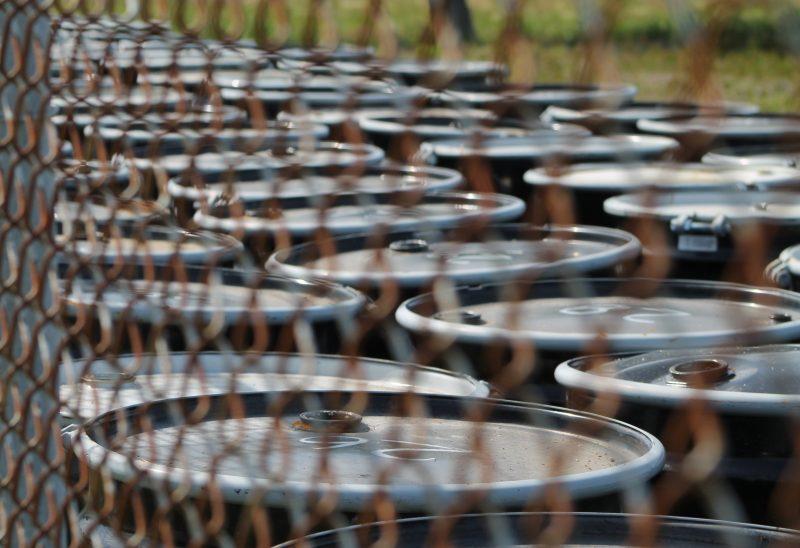
Caption
The smoke stack at the Brunswick Plant is a century-old landmark that can be seen from the causeway connecting the city to St. Simons Island.
Credit: Laura Corley/The Current
|Updated: May 4, 2021 2:54 PM

The smoke stack at the Brunswick Plant is a century-old landmark that can be seen from the causeway connecting the city to St. Simons Island.
Laura Corley, The Current
Jasmin Buggs reeled in her line and looked with dismay at the bare metal hook.
The shrimp bait was gone — again.
Likely it was yanked off by a stealthy stingray or nabbed by a passing whiting.

Jasmin Buggs and her boyfriend spend the day fishing off an old bridge over the Mackat River that once connected St. Simons Island and Brunswick.
Buggs and her boyfriend regularly fish in Mackay River off the edge of an old bridge that once connected Brunswick and St. Simons Island. Though both live locally, neither were aware of any pollution or fish advisory notices on the Back River, the next bridge over, due to suspected pollution from the old Hercules industrial plant. The 152-acre industrial site, marked by the white smoke billowing from a tall smokestack, is visible from the bridge across the marsh.
“I think that’s messed up,” 22-year-old Buggs said looking up from her foam cooler and three long white fiberglass fishing poles when she heard about the polluted site. “People eat these fish.”
For all the natural beauty surrounding the majority minority town of Brunswick and the wealthier white Golden Isles across the causeway, few locals are aware of the myriad environmental dangers surrounding them. Offshore efforts to mitigate oil spills from the Golden Ray wreck offer stark reminders about the region’s fragile ecology, but local environmentalists say older, deadlier threats remain hidden in the marshland where generations of Brunswick families have fished, shrimped and crabbed due to the area’s contaminated industrial sites.
They are working to increase knowledge about pesticide dumps into Terry and Dupree creeks decades ago by a once-prominent local employer, Hercules Inc. It’s an uphill battle, the activists say, because a draft new plan introduced in November to clean up the Terry Creek Superfund site potentially keeps the public in the dark about just how companies hired to finish the cleanup will accomplish that goal decades after federal authorities ordered it done in 1984.
The newest plan to deal with one of Brunswick’s four federally designated environmental disaster zones, called Superfund sites, has some upsides, companies and environmentalists say. The plan allows scientists and engineers flexibility to try different methods of environmental remediation at the plant where Hercules manufactured toxaphene, a chemical that helped eradicate insects that destroyed local cotton crops but was later banned due to health concerns.
But given the opacity of cleanup work since the 1980s, local environmental advocates worry that the draft plan making its way to regulators lacks any requirement for the companies to keep the public informed of changes to the proposal once it is approved by Georgia’s Environmental Protection Division.

“They need to tell us what they’re doing and then if they don’t do it, then we need to hold them accountable,” says Glynn Environmental Coalition Director Rachael Thompson. “We can’t do that if they aren’t being transparent.”
Mark Johnson, attorney with Gilbert Harrell Law Firm, which represents Hercules, acknowledged that communications with the public in the past “weren’t as good as they should have been.”
In an effort to improve that, the company launched a website in February that includes information on the plant’s history, past and current remediation efforts and more. The companies hired to handle the complicated and lengthy cleanup are facing pushback from local activists who say their efforts are not good enough.
The Brunswick plant, off Ga. 17 near the St. Simons Island Causeway, is where manufacturers a century ago turned the stumps of southeastern pines into a global business. Some of Hercules’ products included pesticides called chlordane and toxaphene, which were used to kill boll weevils that had decimated Southern cotton crops. Federal authorities banned both chemicals in the 1980s when studies indicated a linkage to cancer in animals and humans plus harm to the environment.
Hercules Inc., formerly Hercules Powder Co., operated the Brunswick plant for 90 years and manufactured the pesticides for at least 40. The company’s chemicals are among dozens of other poisons like arsenic and chloroform that leached into the sediment at Terry Creek, which flows near the plant, the Hercules landfill, and the Brunswick plant, which is now owned and operated by Pinova Inc.
In 1984, the U.S. Environmental Protection Agency designated Terry Creek as one of the state’s four Superfund sites. The Department of Justice has ruled that Hercules is responsible for its cleanup.
But almost 40 years later, the site remains closed to the public because of lingering contamination.
A draft for a new plan to clean up the site was submitted in November to the state Environmental Protection Division. Public comment on the plan ends May 10.
GEC is among groups pushing for more transparency and communication to the public about the current chapter in the lengthy cleanup process so that the company and government agencies involved can be held accountable for delays and dangers.
“There’s been a lot of studying, a lot of planning, but not a lot of actual cleanup and risk reduction,” said Thompson, adding that the company has repeatedly missed deadlines, even ones it set for itself. “Hercules and Pinova need to be better about communicating with the community, what they’re doing, why they’re doing it (and) if something changes, why it’s changing. That relationship and that communication really has not been what our community deserves.”

At least 100 barrels up against a fence on the edge of the Terry Creek Superfund site contain samples from newly installed wells.
Johnson, the lawyer, agrees that the company could improve its community interaction, but he says the company doesn’t get credit for the significant cleanup work already achieved. Hercules has spent more than $50 million over the past 25 years on environmental remediation at the sites.
“It’s complicated work. It’s even more complicated when you’re dealing with plants that are still operating,” he said. “It’s not like you can just go out there and willy nilly and do what you want to do. You’ve got to coordinate with the current operator and make sure you’re not cutting through power lines and stuff.”
Another area of disagreement is the danger posed by toxaphene to humans. While federal authorities banned the use of the chemical, there is not enough information available on exactly how toxaphene impacts people, particularly as it weathers over time. The data doesn’t exist because no studies have been done.
Finding an answer would take funding for a public health institute willing to take on the research. Such researchers, however, tend to favor current instead of historic environmental threats, Thompson said.
Johnson said it’s “pretty safe to say” there’s no risk posed by contaminants at the site, but “I know others might disagree. … Risk is such a tricky topic. It’s hard to explain. You intuitively know it, but it’s not something that people just naturally think about. Water is risky if you drink too much of it.”
If it weren’t for the fence topped with barbed wire, the locked gate and the “Keep Out” signs, one might never know the grassy field near the F.J. Torres Parkway leading to St. Simons Island is still laden with dangerous industrial chemicals.
On a recent afternoon, a mink scavenged for food near the mouth of a drainage canal known as the Hercules Outfall site. It is a place where wildflowers grow and porpoises swim. Yet it too is part of the Terry Creek Superfund area where Hercules discharged wastewater and where tons of sediment contaminated with toxaphene was dredged and piled.
The canal passes under Ga. 17 connecting the Brunswick Plant with Dupree Creek, which flows into Terry Creek, the Back River and eventually empties into St. Simons Sound.
Every two years the EPD conducts fish tissue sampling in the area. In recent years the fishing advisory was changed from “do not eat” to “eat sparingly” as lab results showed consistently decreasing levels of toxins. The latest sample was sent to a Savannah lab last year but results are still outstanding.
Fishing is more than just a relaxing pastime in this community where poverty rates hover at 20% and many rely on their catch for a source of protein. Among the Gullah-Geechee communities descendent from formerly enslaved people from the west coast of Africa, fishing is part of the culture, where recipes and angling tactics have been passed down for generations.
Road signs on the Back River bridge, about a mile over from where Buggs was fishing, warn anglers of a fishing advisory. The signs direct anglers to the EPD website for more information.
Buggs, who passes over the bridge regularly, said she never noticed the signs.

Jake Grant baits his hook at a bridge over the Mackay River on a recent balmy Tuesday afternoon.
Jake Grant, a 27-year-old who grew up fishing in the area with his grandfather, had not noticed the signs until one recent Tuesday, when he drove up from Jacksonville to cast his bait and hook into the shallow water off the old bridge to St. Simons Island.
Grant questioned its usefulness.
“That being said, knowledge is power and we all have the ability to make our own decision whether eating contaminated fish or FDA-approved McDonald’s,” he said.
The Georgia EPD oversees the Brunswick Plant while the U.S. Environmental Protection Agency oversees the Terry Creek Superfund site on the other side of the highway.
It was the EPA that in 1971 recorded the existence of toxaphene in soil samples, fish tissue, birds and crustaceans.
The pesticide is known to be biomagnified in aquatic environments, meaning its concentration increases in tissues of organisms as it travels up the food chain. It accumulates in fatty tissues of predators and their prey. Even in areas where levels are low or confined, levels of it could be high in individual animals.
Breathing, eating or drinking high levels of toxaphene can damage the nervous system, the liver and kidneys or even cause death, according to the CDC. The pesticide in its original state is an amber waxy solid with a piney smell but it also comes in gas form.
Toxaphene degrades slowly, can be carried long distances in the air and can persist in soil for up to 14 years. Some of the products used to make toxaphene, which also may be toxic, may also pose a risk to residents.
Toxaphene is likely to cause cancer in humans. It can be detected in blood, urine, feces and breastmilk but most doctor’s offices do not offer the test.
Fish safety and human health were issues raised during a recent virtual open house discussing new cleanup plans for the Brunswick plant.
Greg Roush, project manager and geologist for GeoSyntec Consultants, the company Hercules hired to handle the cleanup plan required by Georgia regulators, sought to assure participants that the Hercules-Pinova site posed no risk to the public.
“A lot of work has been done to figure out where the chemicals are and a lot of corrective action work has been done as well,” Roush said. “For there to be risk there has to be exposure, and exposure means … you need to be eating or drinking it, contacting it with your skin or breathing it. The public is not drinking groundwater or being exposed to soil.”
To those who say the cleanup process has taken too long, Roush told them it is akin to “eating an elephant … bite by bite.”
Hercules has touted its willingness to increase its communication with the public. Even so, the company chose not to record any of its public meetings or presentations in March and April about the draft cleanup plan. The plan is required by Georgia’s EPD as part of a new hazardous waste removal permit for Pinova.
Johnson said the law does not require the company to make a recording, a practice that some at the company believed might cause discomfort among participants.
“We kind of talked about that but some people find recordings kind of intrusive,” Johnson said. “We didn’t want to record who was asking questions and who was doing the chat rooms. Some people get freaked out about things.”
Audio from the meeting was recorded by both GEC and The Current. It, along with the accompanying presentation, is available below.
Thompson, who attended several of the meetings, said the draft cleanup plan includes information about several possible technologies to use at the site, but lacks a requirement compelling public disclosure if changes are made to those plans.
Public information and involvement are key to public accountability, she said.
“We think that they should be required to check in and come back and say, ‘Hey, this is what we’ve been working on. Either this, this has been going great, or this has not been going great, you know, kind of like a progress report, if you will, for the community,” she said.
Asked about the absence of such a requirement, Johnson said it was a “good and fair question.”
Johnson said Hercules plans to update the public even if it is not spelled out in the corrective action plan. He also said the company would be agreeable to including those requirements in the plan.
“I hope people understand and desire is really to get out there and get in, get work done,” he said. “We’ve done tons of study, so you know, we’re confident that this works going to improve them. That’s really the goal, is to get this environment safer for everybody.”
This story comes to GPB through a reporting partnership with The Current.